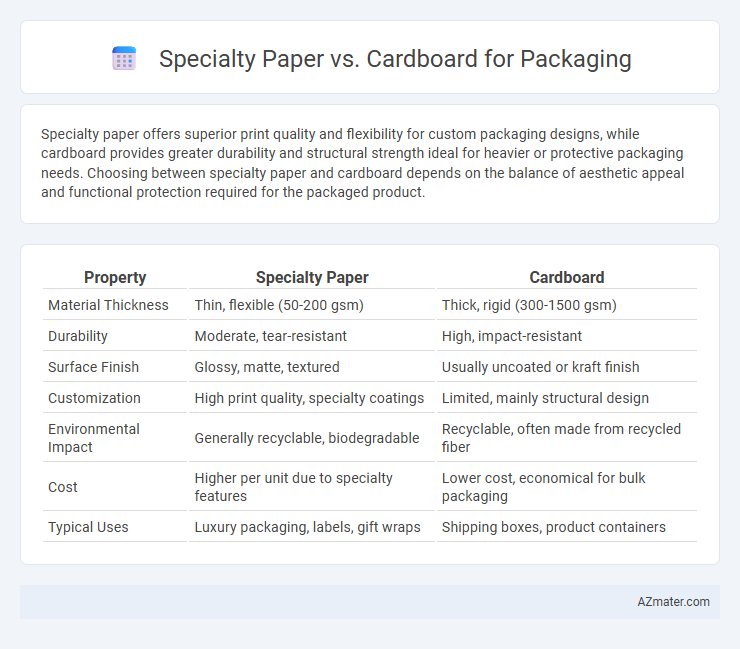Specialty paper offers superior print quality and flexibility for custom packaging designs, while cardboard provides greater durability and structural strength ideal for heavier or protective packaging needs. Choosing between specialty paper and cardboard depends on the balance of aesthetic appeal and functional protection required for the packaged product.
Table of Comparison
| Property | Specialty Paper | Cardboard |
|---|---|---|
| Material Thickness | Thin, flexible (50-200 gsm) | Thick, rigid (300-1500 gsm) |
| Durability | Moderate, tear-resistant | High, impact-resistant |
| Surface Finish | Glossy, matte, textured | Usually uncoated or kraft finish |
| Customization | High print quality, specialty coatings | Limited, mainly structural design |
| Environmental Impact | Generally recyclable, biodegradable | Recyclable, often made from recycled fiber |
| Cost | Higher per unit due to specialty features | Lower cost, economical for bulk packaging |
| Typical Uses | Luxury packaging, labels, gift wraps | Shipping boxes, product containers |
Introduction to Specialty Paper and Cardboard Packaging
Specialty paper offers unique properties such as high durability, moisture resistance, and custom finishes that enhance branding and product protection in packaging applications. Cardboard, typically made from thick, layered corrugated fiberboard, provides excellent structural strength and cushioning, making it ideal for shipping and storage of heavier goods. Both materials serve distinct packaging needs, with specialty paper excelling in presentation and tactile appeal, while cardboard ensures robust protection during transit.
Material Composition and Manufacturing Process
Specialty paper typically consists of high-quality fibers such as bleached kraft pulp, enhanced with coatings or treatments to improve strength, printability, and moisture resistance, while cardboard is a thicker, multi-layered material made from recycled paper fibers combined with virgin pulp to achieve rigidity. During manufacturing, specialty paper undergoes refining, pressing, and coating processes tailored to specific functional or aesthetic requirements, whereas cardboard production involves layering multiple paper sheets using adhesives and corrugation techniques to create durable, impact-resistant packaging. The differences in fiber content and layering methods directly influence the performance characteristics, recyclability, and cost-effectiveness of both materials in packaging applications.
Strength and Durability Comparison
Specialty paper offers high tensile strength and tear resistance suitable for lightweight packaging but lacks the rigidity and impact resistance of cardboard. Cardboard, composed of multi-layered corrugated fiberboard, provides superior durability, puncture resistance, and structural integrity, making it ideal for heavy-duty packaging needs. The enhanced thickness and cushioning properties of cardboard ensure better protection for fragile or bulky items during transit.
Environmental Impact and Sustainability
Specialty paper offers a more sustainable packaging option due to its biodegradability and ease of recycling, reducing environmental footprint compared to cardboard. Cardboard, while also recyclable, often requires more resources and energy for production, leading to higher carbon emissions. Choosing specialty paper supports circular economy goals by minimizing waste and promoting renewable material use in packaging industries.
Cost Analysis: Specialty Paper vs Cardboard
Specialty paper generally incurs higher production costs due to its unique fiber composition and surface treatments, leading to increased packaging expenses compared to cardboard. Cardboard offers a cost-effective alternative with its bulk production and recyclability, reducing overall material and shipping costs. Evaluating factors such as durability, printing quality, and environmental impact helps determine the most economically viable option for specific packaging needs.
Printing and Customization Options
Specialty paper offers superior print quality and a wide range of customization options such as embossing, matte or glossy finishes, and vibrant color reproduction, ideal for high-end packaging designs. Cardboard provides excellent durability and structural support but typically supports more limited printing techniques like flexography and digital printing, focusing on functionality over intricate designs. Choosing between specialty paper and cardboard depends on the desired balance of visual appeal and protective strength in packaging solutions.
Applications in Different Industries
Specialty paper offers superior printability and flexibility for packaging in industries such as cosmetics, pharmaceuticals, and luxury goods, where detailed branding and consumer appeal are critical. Cardboard, favored for its strength and durability, is widely used in electronics, food and beverage, and e-commerce sectors to ensure secure transportation and protection during shipping. Both materials serve distinct roles based on industry requirements, with specialty paper excelling in presentation and cardboard providing robust protection.
Protection and Barrier Properties
Specialty paper offers enhanced protection and superior barrier properties against moisture, grease, and oxygen, making it ideal for packaging sensitive products like food and pharmaceuticals. Cardboard provides robust structural strength and cushioning but typically lacks the advanced moisture and gas barrier capabilities found in specialty paper coatings or laminates. Combining cardboard with specialty paper coatings can optimize both protection and barrier performance for diverse packaging applications.
Consumer Perception and Branding
Specialty paper offers a sleek, high-quality appearance that enhances consumer perception by conveying premium branding and eco-conscious values. Cardboard provides durability and structural support, appealing to consumers who prioritize practicality and sustainability in packaging choices. Brands leveraging specialty paper often emphasize elegance and exclusivity, while cardboard packaging signals reliability and environmental responsibility.
Choosing the Right Material for Your Packaging Needs
Specialty paper offers superior print quality and customization options, making it ideal for high-end packaging requiring intricate designs and branding. Cardboard provides exceptional durability and protection, perfect for heavy or bulky items needing robust support during shipping. Choosing the right material depends on balancing aesthetic appeal with functional strength to meet specific packaging requirements efficiently.

Infographic: Specialty paper vs Cardboard for Packaging
 azmater.com
azmater.com